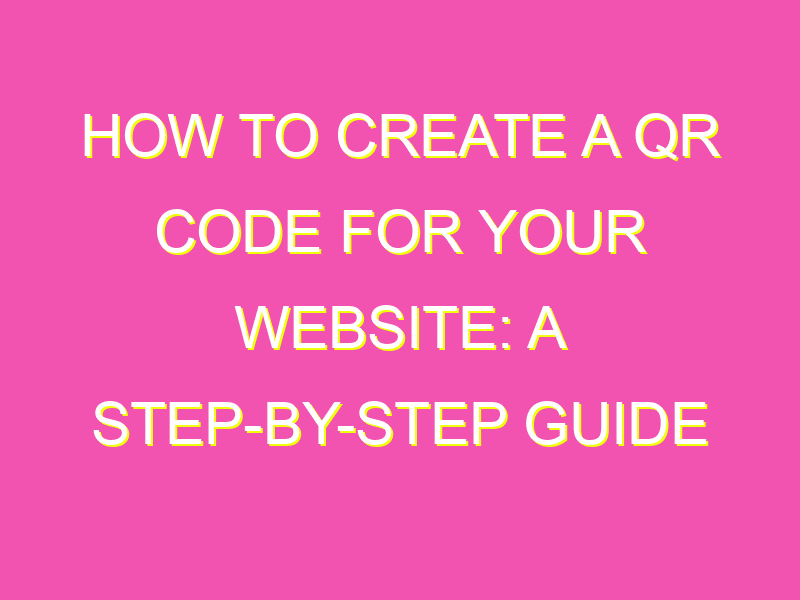Are you tired of losing potential customers because they don’t have time to type in your website address while on the go? Enter the QR code. Quick Response codes are the perfect solution to make your website instantly accessible to anyone with a smartphone or mobile device.
Want to make a QR code for your website? It’s easy! Just follow these 6 steps:
Creating a unique and customized QR code is a simple and effective way to drive traffic to your website. Start making your own QR codes today and make your website accessible to anyone, anywhere, anytime.
Understanding QR Codes and Their Functionality
QR codes (short for Quick Response codes) are two-dimensional barcodes that can store a large amount of data. They function by being scanned by a QR code reader, which can be found on most smartphones. The QR code reader decodes the information and directs the user to a website or other digital content.
QR codes have become increasingly popular in recent years as a way to quickly and easily share information. They can be used for a variety of purposes, including marketing campaigns, product information, and even as a way to make purchases.
One of the advantages of using QR codes is that they are more versatile than traditional barcodes, which can only store a limited amount of data. QR codes can store a wide range of information, including text, URLs, and even contacts.
Choosing a QR Code Generator
Choosing the right QR code generator is crucial for creating effective codes. There are many different tools available online, but not all of them are equal in terms of functionality and ease of use.
When choosing a QR code generator, it is important to look for one that offers customizable options. This will allow you to make your QR code stand out and also ensure that it is easy for your audience to scan.
Additionally, some QR code generators offer analytics and tracking features, which can be helpful for monitoring the success of your campaign.
Some popular QR code generators include QR Stuff, QR Code Generator, and Scanova.
Selecting a Website to Link to Your QR Code
Once you have chosen a QR code generator, the next step is to select a website to link to your code. This could be a product page, a landing page for a marketing campaign, or even a social media profile.
When selecting a website, it is important to choose one that is mobile-friendly and easy to navigate. This will ensure that users have a positive experience when they scan your code and visit your website.
Additionally, it is important to make sure that the website you link to provides value for your audience. This could mean providing helpful information, offering a discount or promotion, or even just entertaining content.
Creating Your QR Code
Creating a QR code is a relatively simple process. Most QR code generators will allow you to customize the code by adding color, logos, or other branding elements.
To create your QR code, follow these simple steps:
1. Choose the type of information you want to include in the code (e.g. a URL, text, or contact information).
2. Enter the information into the QR code generator.
3. Customize the code by adding branding elements.
4. Download the code.
Tips for Designing an Effective QR Code
When designing your QR code, there are a few things to keep in mind to ensure that it is effective:
1. Use high-contrast colors to make the code stand out.
2. Make the code large enough to be easily scanned.
3. Test the code on multiple devices to ensure that it works on different types of smartphones.
4. Provide clear instructions for how to scan the code.
5. Link the code to content that is relevant and valuable for your audience.
Printing and Sharing Your QR Code
Once your QR code is created, it can be printed on a variety of materials including business cards, flyers, and posters. When printing your code, be sure to make it large enough to be easily scanned.
Additionally, it is important to share your code through digital channels as well. You can include your QR code in social media posts, email signatures, and other digital marketing materials.
Tracking the Success of Your QR Code Campaign
Tracking the success of your QR code campaign is important for understanding the effectiveness of your marketing efforts. Many QR code generators offer analytics and tracking features that can help you monitor key metrics such as scans, click-through rates, and engagement.
Some tips for tracking your QR code campaign include:
1. Set specific goals for your campaign (e.g. number of scans, conversions, etc.).
2. Use a unique landing page for each code to track the success of individual campaigns.
3. Monitor your analytics regularly and use the data to make adjustments to your campaign.
By following these tips, you can create effective and engaging QR code campaigns that drive traffic, increase engagement, and help you reach your marketing goals.





